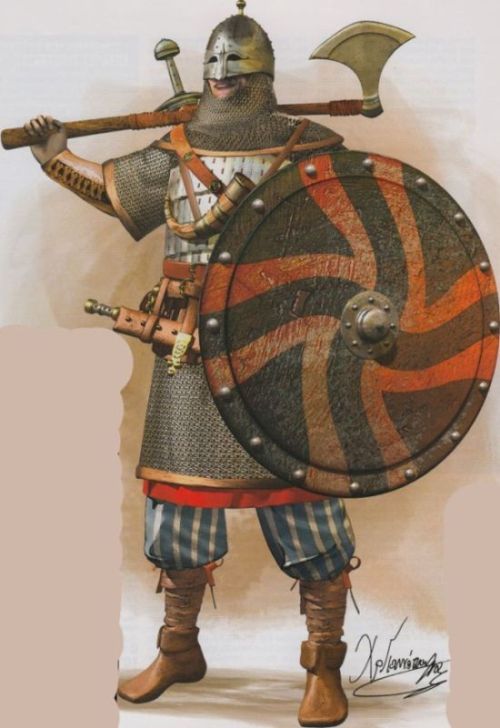peashooter85:The Varangian Guard — The Eastern Roman Empire’s elite Viking soldiersIn the mid 8th ce
peashooter85:The Varangian Guard — The Eastern Roman Empire’s elite Viking soldiersIn the mid 8th century AD viking raiders from Sweden began raiding lands to the east in what is now Russia, Ukraine, and Belarus. After several decades these Norsemen began to conquer plots of land, form permanent settlements, and intermarry with the Slavic peoples in the region. In 882 Prince Oleg began to unite the various Slavic, Norse, and Finnic tribes into a federated state called the Kievan Rus. The Kievan Rus would grow to dominate much of Eastern Europe from the 10th century until the Mongol invasions in the 13th century.After the founding of Kievan Rus it wasn’t long before they made contact with the Eastern Roman Empire, or as it is called by historians, “the Byzantine Empire”. In 988 the Byzantine Empire was facing tumultuous times, not only having to deal with foreign invaders but a large rebellion which threatened to fracture the empire. The Byzantine Emperor, Basil II, made a request from Vladimir I of Kiev for 6,000 soldiers in return for his sister’s hand in marriage. Vladimir accepted the offer and sent 6,000 hardy Norsemen to fight as mercenaries in the Byzantine Army. The Norsemen fought so well that he made them his elite shock troops as well as his personal bodyguard. The word “Varangian” itself comes from the Old Norse words “var” (to pledge or swear) and “gengi” (companions). With the Varangian Guard at the head of the Byzantine Army, Basil II was able to crush the rebels, drive back enemy invaders, and stabilize the empire. He made the Varangian Guard an official institution of the empire, much like the Praetorian Guard of ancient Rome, and sent out a call for men from all over Scandinavia to fill in his ranks and expand the guard. Armed with a sword, a large double handed axe called a Dane Axe, mail or lemellar armor, a shield, and a helmet, the Varangians would see combat all over the empire including in the Balkans, Greece, Italy, Turkey, and the Middle East. Rewards for service included large cash payments and land.One of the most important Varangians in Medieval history was a Norwegian noble named Harold Sigurdsson. After losing a battle to his family rivals he was exiled to Kievan Rus in 1031. A few years later he joined the Byzantine Army, earning a reputation as a brave soldier and brilliant military leader, until eventually he was promoted as commander of the Varangian Guard. After a successful career as a Varangian, Harold returned to Norway and reclaimed his throne, taking the title King Harold III. In 1066 he invaded England in an attempt to take the English throne, but was defeated and killed at the Battle of Stamford bridge by the army of Anglo Saxon King Harold Godwinson. History would forever remember him as Harold “Hardrada”, the stern ruler.Speaking of 1066, after the defeat of Harold Hardrada in 1066, Godwinson and his army was forced to march south to do battle with another army, a Norman invasion led by William the Bastard, later known as William the Conqueror. Godwinson would be defeated by William the Conqueror resulting in the Norman conquest of England. This would have profound effects on the Varangian Guard. By the mid 11th century Scandinavian peoples no longer sought to go-a-viking like their ancestors had done, preferring to settle down and become farmers and merchants. Harold Hardrada is often called “the last Viking”, and his death in 1066 is commonly used as a closing point of the Viking Age. As a result, fewer and fewer Norsemen volunteered for the Varangian Guard. However, the Norman conquest resulted in many Anglo-Saxon refugees fleeing from England. Many of these English expats would join the Byzantine Army and fill in the empty ranks of the Varangian Guard until by the 12th century the guard was completely dominated by Anglo-Saxons.Over time the Varangian Guard would decline along with the Byzantine Empire, slowly being ground down by invaders who attacked from all sides of the empire. By the late 13th century it is thought the Varangians were merely a simple palace guard that was a shadow of their former selves. The last mention of the guard occurs around 1400, and from there they disappeared into history. -- source link


